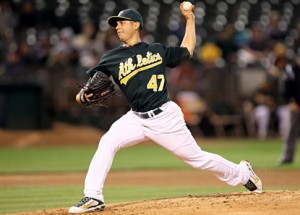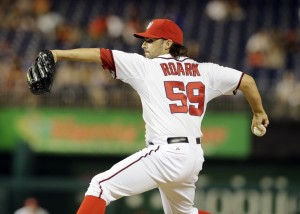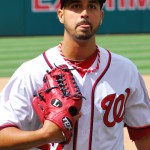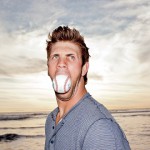
Was getting Gonzalez the "biggest" trade the franchise has ever made? Photo Jed Jacobsohn/Getty Images via nydailynews.com
In response to a topic that came up in the comments section, I’ll do a 3-part series reviewing the biggest/best/worst moves by the franchise since arriving here in Washington. We’ll differentiate between Jim Bowden and Mike Rizzo moves as we go through. We’ll talk about trades, then draft picks, then FA signings.
First up: Trades.
The Nats have made dozens of trades since 2005, and by my records have traded with every team in the league save for three: Baltimore, Cleveland and the Los Angeles Angels. In fact, the franchise has not done business with Baltimore in any capacity since the year 2000, a testament perhaps to the difficulties of dealing with Peter Angelos even before the team moved to Washington. Now post-relocation, the conventional wisdom is that the two teams would never do business on the off-chance that one team ended up “winning” a trade with the other.
I’ll divide this post into into 3 sections: the “biggest” deal (not the most players, but the biggest impact/most news worthy), the “best” deal(s) and the “worst” deals. For Rizzo, we’ll add a 4th category for “Too Early to Tell,” since the big off-season trade of last season probably won’t shake it self out for a few more years.
Jim Bowden Tenure: Nov 2004 – Mar 2009
Biggest Trades
- 2005: Soriano deal
- 2006: Kearns/Lopez deal
- 2007: Milledge deal
- 2008: Willingham/Olsen deal
The Alfonso Soriano move made all sorts of news; he wouldn’t move to LF, threatened not to play at all, then ended up putting in a 40/40 season in a pitcher’s ballpark and then resulted a host of national news as the team debated whether to trade him, re-sign him or let him go. Bowden held firm on his demands in the trade market, never traded him and landed two compensatory draft picks (which the Nats turned into Jordan Zimmermann and Josh Smoker).
The Kearns/Lopez deal, in the end, was more about moving deck chairs than making progress for either team. Bowden was obsessed with players that he knew from his Cincinnati days, and showed a proclivity to trade for or acquire them throughout his tenure here, and this deal was just the biggest example. The only player in the deal who still remains with his original team is Bill Bray, and most of the players in the deal have become large disappointments for their careers or are out of baseball. The Reds accused Bowden publically of selling them damaged goods (Gary Majewski got injured about 5 minutes after the trade was completed) and Kearns/Lopez never really lived up to anything close to their potential.
We’ll talk about the other two deals below.
Best Trades
- 2007: Getting Tyler Clippard
- 2009: Getting Michael Morse
- 2008: Getting Willingham/Olsen
Bowden gets major credit for obtaining two core members of the current Nationals squad for almost nothing. He obtained Tyler Clippard from the Yankees for Jonathan Albaladejo in a like-for-like trade of under-performing minor league relievers. Of course we all know what’s happeend since; Clippard has become a super-star setup man, the 2011 league leader in holds. Getting Michael Morse in return for sending the feeble Ryan Langerhans to Seattle in what most thought was a mercy trade at the time (i.e., trying to send good-guy Langerhans to a team that would actually play him) seems like one of the steals of the decade. Nobody thought Morse had a fraction of the potential he’s now shown to have.
I include getting Josh Willingham and Scott Olsen as a win based on who we gave up: PJ Dean, Emilio Bonifacio and Jake Smolinski. I’ve always had a soft spot for Willingham and thought his offense potential was the key to this deal; we got two major leaguers for two dead-end minor leaguers plus a backup infielder. Luckily for the Nats, Florida was always ready to give up arbitration candidates to save a buck.
Worst Trades
Honestly, I had a hard time really saying that I thought one of Bowden’s trades was egregiously bad. Most of his deals (outside the deals mentioned above as biggest or best) were minor leaguer swaps or dumping veterans at the trade deadline. Even the acquisition of Elijah Dukes wasn’t really that “bad” based on who we gave up (Glenn Gibson, who was released a couple years later by Tampa Bay and ended up back with us anyway).
However, the acquisition of Lastings Milledge for Ryan Church and Brian Schneider might be the one trade that I’d most quibble with. Bowden showed his obsession with “toolsy” and “potential” players in this deal, acquiring the malcontent Milledge and giving the Mets two immediate starters. At the time I certainly defended the deal; neither Church or Schneider were slated to be starters for the 2008 Nats so you could argue that we got a plus prospect for two backups. I know I certainly argued that point. Church seemed to be a brooding platoon outfielder who wouldn’t be happy unless he was starting and Schneider had lost his starting spot to Jesus Flores and was a relatively weak hitter.
As it has worked out Church was a very productive player for New York, Flores got hurt and left the team in a very serious catcher-dearth position, and Milledge turned out to be not nearly the talent that we thought we were getting. By the time we flipped him to Pittsburgh in 2009 he was barely hitting his weight in AAA and was completely out of the picture for this team.
Mike Rizzo Tenure: Mar 2009 – present
Biggest Trades
-
2011: Gio Gonzalez deal
-
2009: Morgan/Burnett deal
-
2010: Ramos for Capps deal
-
2011: Henry Rodriguez/Willingham deal
-
2011: Gorzelanny deal
You have to hand it to Mike Rizzo; he’s not been afraid to make deals. In his 3 year tenure he’s made 5 significant deals that have vastly changed the way this team is constructed. Two of those deals (Morgan/Burnett and the Willingham deals) were mostly about cleaning up the roster to get it more in his image of pro-clubhouse guys and pro-defense. Trading away Milledge and Willingham succeeded in moving the team towards these goals. The Gorzelanny and Gonzalez trades were about acquiring power arms to shore up the rotation, another tenant of Rizzo-constructed teams.
Best Trades
- 2010: getting Wilson Ramos
Clearly Rizzo’s best move was stealing Wilson Ramos for a closer (Matt Capps) that we had ample candidates for internally. The Twins panicked post-Joe Nathan injury and overloaded their bullpen with closer candidates. Meanwhile Rizzo turned an astute FA signing (a minor league signing that turned into an All Star) into an even more astute trade by getting a nearly MLB-ready catcher in return for a guy who the team wouldn’t be re-signing anyway. Great move.
Worst Trades
- 2011: Gomes for Rhinehart/Manno
- 2009: Bruney for ptbnl (eventually rule5 top pick Jamie Hoffman)
Most readers here loved Christopher Manno and the promise he was showing in A-ball. Most were also aghast to see Manno go the other way to Cincinnati for a 4th outfielder Jonny Gomes. At the time, the argument was that Davey Johnson wanted a bat off the bench and that the team needed some OF depth. What really happened was that Gomes hit his way out of his type-B arbitration status and played so poorly the 2nd half of 2011 that the team couldn’t dare offer him arbitration to get a compensatory draft pick. So we traded two decent prospects for a half season of awful production. Not a good move.
Even worse, trading anything to acquire Brian Bruney. The team acquired Bruney, promptly argued against him and beat him in arbitration, and then (unsurprisingly) Bruney vastly underperformed until being flat out released a few months into the 2010 season. For me this is a lesson in what not to do with your arbitration eligible players. It wasn’t so much what we gave up (the first pick in the rule-5 draft *could* have been used to acquire someone of value), it was what we got in return.
Too Early to Tell Trades
Pro-prospect pundits (anyone at Baseball Prospectus, Keith Law, etc) will already tell you that the Nats vastly overpaid for Gio Gonzalez. That’s because they value the potential of prospects more than the proven commodity of the major league player. But the fact is this; you KNOW what you’re getting in Gonzalez but you have no idea how a low-A prospect will play out. The Nats rolled the dice that AJ Cole isn’t going to turn into the next incarnation of Justin Verlander and that Brad Peacock‘s promise will peak as a middle reliever. The only way to tell how this trade turns out is to track the progress of those players we gave up versus what Gonzalez does for this team over the next 3-4 years.
Thoughts? Any trades out there that stick in your minds that you thought should be mentioned?



